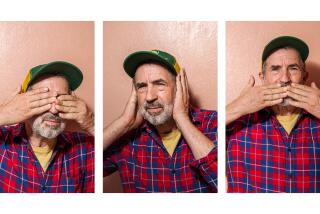‘Running Wild’ follows Dayton O. Hyde, cowboy conservationist
- Share via
Dayton O. Hyde is a cowboy Renaissance man.
He’s an award-winning author whose books, such as “One Summer in Montana,” reflect his passion for the American West and its wildlife. Last year, Hyde, 88, published his first book of cowboy poetry, “Alone in the Forest.”
For years, Hyde also operated a successful cattle ranch in Oregon that once belonged to his uncle. It’s where he and his wife raised five children.
A tireless conservationist, Hyde rejuvenated a lake near the ranch and saved the sandhill crane from extinction. His book “Don Coyote” chronicled his efforts to protect coyotes that were being poisoned by his neighbors.
Then in 1988, he began another chapter in his life. He left the family ranch and, using credit cards and a government-sponsored loan, purchased 11,000 acres in the Black Hills of South Dakota and opened the Black Hills Wild Horse Sanctuary. The area is a refuge for wild mustangs that Hyde rescued from controversial government wild horse roundups.
Now he’s the subject of a documentary, “Running Wild: The Life of Dayton O. Hyde,” which opens in L.A.-area theaters Friday.
During a recent phone interview, Hyde was modest about his accomplishments. “I have lived a long time,” he said. “I have had time for numerous things. I suppose I get bored easily if life isn’t exciting.”
He admitted he hasn’t had the time to write recently.
“I’m busy taking care of 600 horses,” said Hyde. “I just have to steal moments to write. When an idea comes to me, I do nothing else. I just sit and get it written, whether it is a book or an article.”
PHOTOS: Celebrities by The Times
“Running Wild” director Suzanne Mitchell first encountered Hyde 21 years ago while she was looking for subjects for a People magazine 20th anniversary TV special. “I came across this article about Dayton,” she said. “He was sitting on a ranch house porch and there was another little picture of these wild horses in the background.”
Mitchell spent several days with Hyde at the sanctuary, even though she knew his sequence in the program would have less than two minutes’ screen time. “He started telling me stories about his life and we became friends,” she said.
She cried when she left him. “Dayton was sitting by himself on this massive, expansive land on a log stump waving goodbye. I said to my cinematographer, Mauro Brattoli, ‘We have met the most incredible guy. We should do a film.’”
Ten years later, she began working on “Running Wild,” which ended up being a decade-long process of starts and stops.
PHOTOS: Hollywood backlot moments
“My hope always was not just to tell Dayton’s story, but to inspire people the same way he inspired me,” she said.
Hyde has always had an affinity for animals. “I enjoy their company,” he said.
“I think animals are just as important as people. When I was a child I was alone a lot of the time wandering in the woods and I noticed that animals weren’t afraid of me. Sometimes a grouse would fly up and sit on my arm as I walked, probably because I wasn’t putting out any energy field for them to be afraid of. So animals have always been a special friend.”
He first encountered the plight of mustangs in the 1980s when he was buying cattle in Lovelock, Nev. Hyde said he was appalled when he saw a couple of thousand wild horses rounded up by the government that were, in his view, “incarcerated” in a holding field.
“They were were a sad bunch,” he said. “I just had to do something about them. I owe them a great deal of joy.”
This year has been a difficult one for Hyde and the sanctuary. He’s trying to raise funds to pay for the hay he feeds the horses during the harsh winter months. Because of a horrible drought that extends to Texas, hay prices have skyrocketed and “all the local hay supplies have been shipped to other states. We still need to buy hay to get through the winter.”
And Hyde’s ongoing battle to stop uranium mining in the area, which is chronicled in the documentary, is heating up once again with various meetings regarding permits and water issues.
“It’s going to hurt all the wonderful Black Hills of South Dakota,” he said of the mining. “I am fighting for the future of horses and the wildlife.”
ALSO:
‘Breaking Bad’: Six movies the Bryan Cranston show evoked
NYFF 2013: At 72, fashion icon Agnes B. begins a new phase
Hollywood Black Film Festival: Movies, panels and a beauty lounge
More to Read
Only good movies
Get the Indie Focus newsletter, Mark Olsen's weekly guide to the world of cinema.
You may occasionally receive promotional content from the Los Angeles Times.








